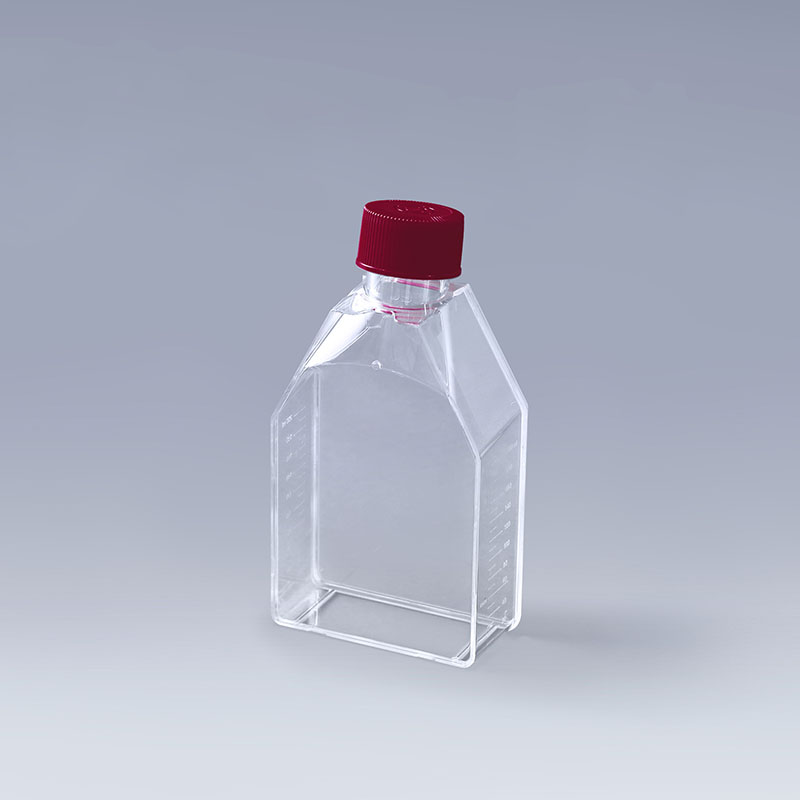In the field of cell culture, selecting the appropriate consumables is critical to the success of an experiment. Cell culture flasks are one of the most commonly used consumables, offering a variety of specifications and designs to meet different experimental needs. This guide will delve into the main features of cell culture flasks and provide insights on how to choose the best option for your laboratory.
1. Transparency and Visibility
Cell culture flasks are typically made of high-transparency polystyrene, allowing researchers to easily observe cell growth and condition. Whether monitoring cell proliferation or checking for morphological changes, the transparent flask body provides excellent convenience for real-time observation.
2. Surface Treatment Options
Cell culture flasks come in two main types: TC-treated (Tissue Culture treated) and non-TC-treated surfaces.
TC-treated flasks are ideal for adherent cells, as the surface is treated to promote better cell attachment.
Non-TC-treated flasks are better suited for suspension cells, as the smooth surface discourages cell adhesion, providing an optimal environment for suspension cultures.

3. Design and Functionality
Several design features enhance the usability of cell culture flasks:
Wide neck design: Ensures easy access for pipettes and cell scrapers, making it convenient to handle cells without missing any areas.
Vented bottom: Allows for quick gas exchange and reduces the time needed to equilibrate the flask when moving from room temperature to an incubator, maintaining a stable cell culture environment.
4. Cap Types
There are two types of caps for cell culture flasks:
Vented caps: Suitable for experiments requiring open culture conditions, allowing for efficient gas exchange while maintaining sterility.
Sealed caps: Designed for closed culture conditions where airtightness is required. The vented cap typically includes a breathable membrane that allows gas exchange without compromising the flask's airtightness.
Key Considerations for Flask Selection
Cell type: Determine whether your cells are adherent or suspension-based, as this will guide the choice of surface treatment.
Culture conditions: Choose between vented or sealed caps depending on whether your experiment requires open or closed culture conditions.
Flask size: Consider the scale of your experiment to ensure that the flask's size and volume meet the demands of your cell culture process.
Conclusion
Selecting the right cell culture flask depends on the specific requirements of your cells and experimental environment. By choosing the correct surface treatment, cap type, and flask design, you can ensure optimal results in your cell culture work. Fudao Biotech, specializing in high-quality biological consumables, offers premium cell culture flask solutions to help take your experiments to the next level.
The FAI climbed 5.9 percent year-on-year in the first 11 months of 2018, quickening from the 5.7-percent growth in Jan-Oct, the National Bureau of Statistics (NBS) said Friday in an online statement.
The key indicator of investment, dubbed a major growth driver, hit the bottom in August and has since started to rebound steadily.
In the face of emerging economic challenges home and abroad, China has stepped up efforts to stabilize investment, in particular rolling out measures to motivate private investors and channel funds into infrastructure.
Friday's data showed private investment, accounting for more than 60 percent of the total FAI, expanded by a brisk 8.7 percent.
NBS spokesperson Mao Shengyong said funds into weak economic links registered rapid increases as investment in environmental protection and agriculture jumped 42 percent and 12.5 percent respectively, much faster than the average.
In breakdown, investment in high-tech and equipment manufacturing remained vigorous with 16.1-percent and 11.6-percent increases respectively in the first 11 months. Infrastructure investment gained 3.7 percent, staying flat. Investment in property development rose 9.7 percent, also unchanged.
 English
English


















































